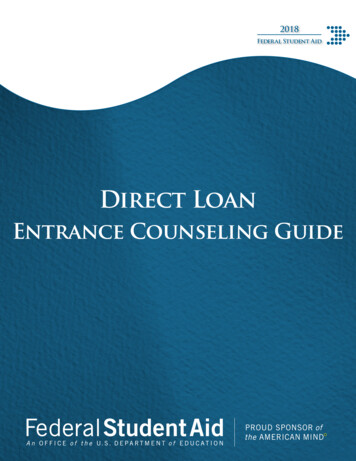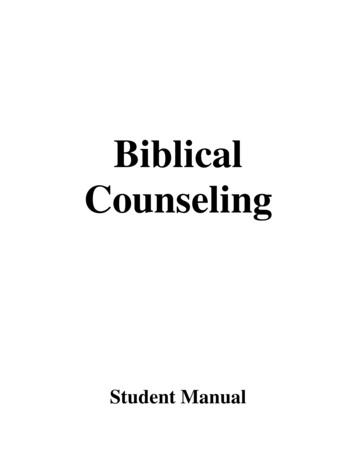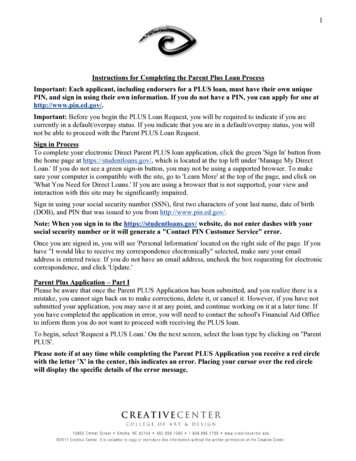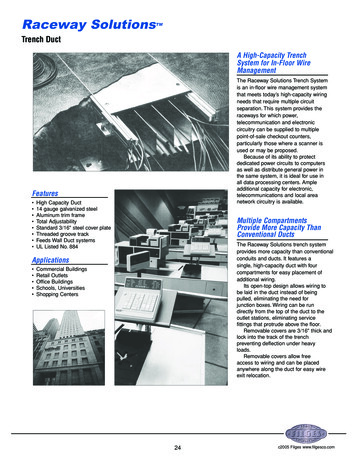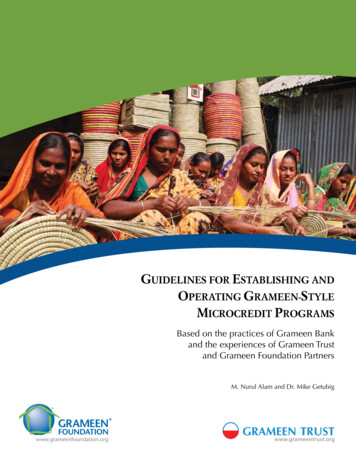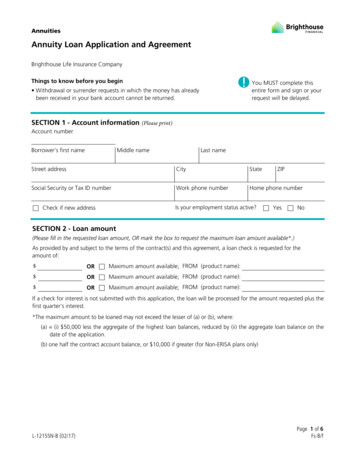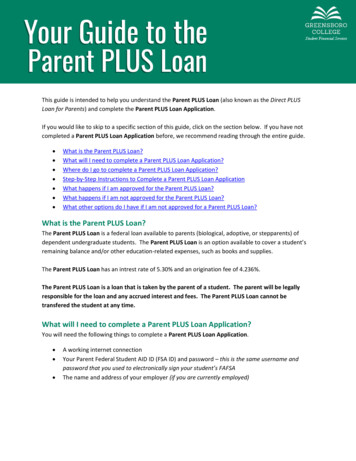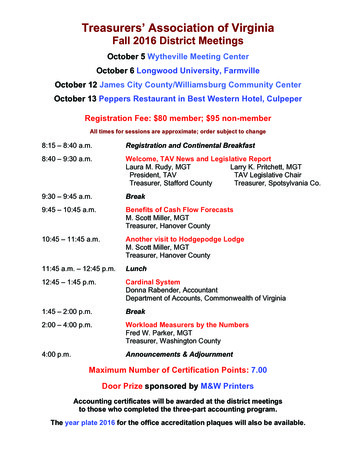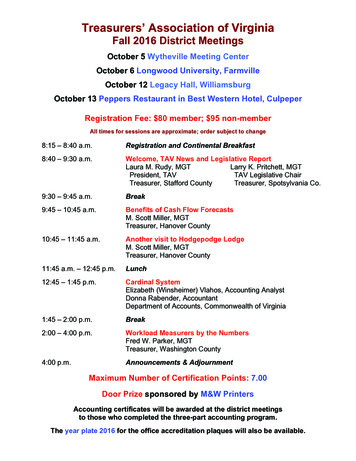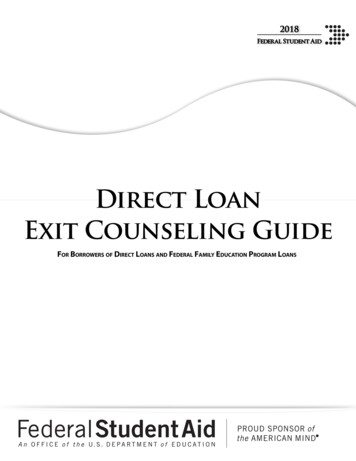
Transcription
2018Federal Student AidDirect LoanExit Counseling GuideFor Borrowers of Direct Loans and Federal Family Education Program Loans
U.S. Department of EducationBetsy DeVosSecretaryFederal Student AidJames ManningActing Chief Operating OfficerFederal Student Aid, an office of the U.S. Department of Education, ensures that alleligible Americans benefit from federal financial assistance—grants, loans and work-study programs—for education beyond high school. By championing the promise of post secondary education, we upholdits value as a force for greater inclusion in American society and for the continued vitality of America as a nation.Need More Information, or Have a Comment?If you are a borrower with questions about the Direct Loan Program or your Direct Loans, you should contactyour loan servicer, or the websites or the offices described in the content of this publication.If you have general questions about the federal student aid programs,you may call the Federal Student Aid Information Center (FSAIC) at1-800-4-FED-AID (1-800-433-3243),TTY (for the hard of hearing) 1-800-730-8913,Locations without access to 800 numbers 1-334-523-2691.You can email FSAIC at studentaid@ed.gov.2018July 2016, revised August 2017 and June 2018.All URLs were last accessed on MAY 30, 2018.Direct Loan Exit Counseling GuideFor Borrowers of Direct Loans andFederal Family Education Program Loans
Table of ContentsIntroduction. 1Terms Used in this Guide. 1Chart: Loan Holders and Servicers for Direct Loans and FFEL Program Loans.2Welcome to Exit Counseling. 4The Federal Student Loan Programs Covered in this Guide. 4Types of Direct Loans and FFEL Program Loans. 5Chart: Types of Federal Student Loans.5Time Limitation on Direct Subsidized Loans. 6Interest Rates in the Direct Loan Program.7Repayment. 8Chart: Repayment Plan Options for Direct Loans and FFEL Program Loans.9Chart: Flexible Repayment Plan Options for Direct Loans . 11Chart: Estimated Monthly Payments for Direct Loans and FFEL Program Loans. 12Repayment Incentives.14Navigating Repayment.14Your Repayment Obligation—Avoiding Delinquency and Default.15Strategies for Avoiding Delinquency and Default.16Loan Consolidation.19Loan Forgiveness and Discharge.20Resolving Student Loan Disputes.21Financial Planning and Debt Management.22Your Credit and Identity.23Helpful Resources.24Student Contact Information and Acknowledgment.25Your Rights and Responsibilities as a Borrower.27Exit Guide July 2018i
Important!You never have to pay for help with your student loans.Free assistance with managing your loans is provided by your federal loan servicer.There is a growing number of so-called commercial student loan debt relief companies thatclaim to offer assistance in managing your federal student loans for a fee. Despite what thesecompanies claim, there’s nothing a student loan debt relief company can do for you that youcan’t do yourself for free with the assistance of your federal loan servicer.If you ever need assistance, the Department of Education and our federal loan servicers willhelp you at no cost!For more information on avoiding loan scams, go g-loan-scams.If you’re having problems managing your student loans contact your federal loan servicer orthe Federal Student Aid (FSA) Ombudsman Group.iiExit Guide July 2018
IntroductionThis guide provides an overview of information you will need to successfully repay the federal student loan(s) that you’vereceived to help pay for your college costs under the William D. Ford Federal Direct Loan (Direct Loan) Program and theFederal Family Education Loan (FFEL) Program. For more detailed information about many of the topics covered in thisguide, see your Master Promissory Note (MPN). If you have an FFEL Program loan, you can find a copy of your Borrower’sRights and Responsibilities on your loan servicer’s website.For Direct Loans, you can find this statement by going tohttps://StudentLoans.gov/myDirectLoan/logging in, scrolling down the page, and selecting either the PDF version of the Master Promissory Note (MPN) for DirectSubsidized and Unsubsidized Loans, or the PDF version of the Federal Direct PLUS Loan Master Promissory Note (MPN) fora graduate/professional student.Exit counseling can be completed on paper or on the web. Please check with your school to see how (paper or web) it expectsyou to fulfill the exit counseling requirement.Warning!Your federal student loan immediately becomes due and payable if your eligibility for theloan was established by making a false statement.Terms Used in This GuideNote: Throughout this guide, the words “we,” “us,” and “our” refer to the U.S. Department of Education. You will alsofrequently encounter the words “loan holder,” “loan servicer,” and “Master Promissory Note.” To assist you, weprovide the definitions for those and other terms within this publication.You can find an expanded glossary of terms at —Demand for immediate repayment of your entire federal student loan. The entire unpaid amount of yourfederal student loan becomes due and payable if you receive loan money, but don’t enroll at least half-time at the school that determined you were eligible to receivethe federal student loan; use your loan money to pay for anything other than expenses related to your education at the school thatdetermined you were eligible to receive the federal student loan; make a false statement that causes you to receive a federal loan that you’re not eligible to receive; or default on your federal student loan.Exit Guide, July 20181
Direct Loan Exit Counseling GuideAggregate Loan Limit—A limit on the total amount of FFEL or Direct Subsidized Loans and/or Unsubsidized Loans that youmay borrow for undergraduate and graduate study. If the total amount you receive over the course of your education reachesthe aggregate loan limit, you will not be eligible to receive additional loans. However, if you repay some of your loans to bringyour outstanding loan debt below the aggregate loan limit, you could then borrow again, up to the amount of your remainingeligibility under the aggregate loan limit.Annual Percentage Rate (APR)—The actual yearly cost of borrowing money reflected as a percentage rate.Capitalized Interest (Capitalization)—Unpaid interest that has been added to the principal balance of a federal student loan.Future interest is charged on the increased principal balance, and this may increase the amount of your monthly payment andthe total amount you repay over the life of the federal student loan.Federal Student Loan—In this guide, loans made under the Direct Loan Program, Federal Perkins Loan Program, and theFederal Family Education Loan (FFEL) Program.Grace Period—For certain types of federal student loans, a period of time (generally six months) after you graduate or dropbelow half-time enrollment during which you are not required to make payments. The repayment period for your loan beginsafter the end of the grace period.Interest—The cost of borrowing money. Interest is calculated as a percentage of the outstanding (unpaid) principal balance.Loan Discharge (Cancellation)—The elimination of a loan debt under certain limited circumstances.Loan Forgiveness—The elimination of a loan debt under one or more of the various Direct Loan forgiveness programs.Loan Holder—The U.S. Department of Education is your loan holder. Your loan servicer will be different than your loanholder (see below).Loan Servicer—An entity that collects payments on a federal student loan, responds to customer service inquiries, andperforms other administrative tasks associated with maintaining a loan on behalf of a loan holder. A loan servicer performs allservicing tasks on behalf of the U.S. Department of Education. A current listing of federal loan servicers for federally held loansmade through the Direct Loan Program can be found at d/servicers.Loan Holders and Servicers for Direct Loans and FFEL Program LoansDirect Loan ProgramWho is the loan holder?The U.S. Department of EducationA bank, school, other organization, or the U.S. Department ofEducationWho is the loanservicer?An organization assigned by the U.S.Department of EducationAn organization assigned by the loan holderMany organizations that service DirectLoans also service FFEL Program loans.122Federal Family EducationLoan Program 1, 2Many organizations that service FFEL Program loans alsoservice Direct Loans.It’s important to note that, while loans made under the FFEL Program were in many cases made by banks, they are not “private”student loans. Loans that were made under the FFEL Program have the same protections and most of the repayment options asloans made under the Direct Loan Program.The authority to make new FFEL Program loans ended June 30, 2010.Exit Guide July 2018
2018Principal—The loan amount you borrow plus any capitalized interestPromissory Note—A legally binding agreement that contains the terms and conditions of the loans made under the note.Most federal student loans are made under a Master Promissory Note (MPN).Master Promissory Note (MPN)An MPN is a binding legal document that you must sign before receiving your first Direct Loan.The same MPN can be used to make one or more loans for one or more academic years (up to10 years). Therefore, if you leave school and return, you may be able to receive additional loanswithout signing a new MPN. An MPN lists the terms and conditions under which you agree torepay the loan and explains your rights and responsibilities as a borrower. It’s important to readyour MPN and keep it in a safe place because you’ll need to refer to it later when you beginrepaying your loan or at other times when you need information about provisions of the loan,such as deferment or forbearance.Identifying Your Loan ServicerYou can identify the servicer for your Direct Loan(s) by going to the National Student Loan DataSystem (NSLDS) website at www.nslds.ed.gov/nslds SA/, and logging in with your FSA ID. The sitewill open to your Financial Aid History Page. Select one of your loans to see the loan detail. In thesection labeled “Make a Payment” you’ll find the loan servicer for that specific loan.Exit Guide July 20183
Direct Loan Exit Counseling GuideWelcome to Exit CounselingWho should use this guide?Student borrowers who are graduating, leaving school, or dropping below half-time enrollment are required to complete exitcounseling.Why?Exit counseling is required by law. Exit counseling provides important information that you will need as you prepare to repayyour federal student loan(s). During exit counseling, you will review the terms and conditions that apply to yourfederal student loans.How do I fulfill the exit counseling requirement?Check with your school to see how (paper or on the web) it expects you to fulfill the exit counseling requirement.Information you should have on hand for exit counseling:1.Outstanding balance(s) on your federal student loan(s):This information can be found athttps://nslds.ed.gov/npas/index.htm.2.Names, addresses, email addresses, and phone numbers for your next of kin, two references who live in the United States, and your employer or future employer (if known).The Federal Student Loan Programs Covered in This GuideDirect and FFEL Loans—Loans made under the William D. Ford Federal Direct Loan (Direct Loan) Program and the FederalFamily Education Loan Program (FFEL Program) generally have the same terms and conditions. Depending on which loanprogram(s) the school(s) you attended participated in, you may have received Direct Loans, FFEL Program loans, or both.William D. Ford Federal Direct Loan (Direct Loan) Program—Through the Direct Loan Program, the U.S. Department ofEducation provides loans to eligible students at participating schools. Direct Loans include the following: Direct SubsidizedLoans, Direct Unsubsidized Loans, Direct PLUS Loans, TEACH Grants converted to Direct Unsubsidized Loans, and DirectConsolidation Loans. You repay your Direct Loan to the U.S. Department of Education.Federal Family Education Loan (FFEL) Program—Federal student loans borrowed through private lenders and guaranteed bythe federal government. FFEL Loans include the following types of federal student loans: Subsidized and Unsubsidized FederalStafford Loans, FFEL PLUS Loans, and FFEL Consolidation Loans. You repay your FFEL Loan to the lender, secondarymarket, guaranty agency, or the U.S. Department of Education. If your FFEL Loan was sold to the U.S. Department ofEducation, you repay your FFEL Loan to the U.S. Department of Education. Note: The FFEL Program ended on June 30, 2010,and no new loans have been made under the FFEL Program after that date.It’s important to note that, while loans made under the FFEL Program were in many cases made by banks, they are not privatestudent loans. Loans that were made under the FFEL Program have the same protections and most of the repayment optionsas loans made under the Direct Loan Program.4Exit Guide July 2018
2018Types of Direct Loans and FFEL Program LoansYou may have received more than one type of loan under the Direct Loan Program or FFEL Program. Each loan type has itsown terms and conditions, such as interest rates. In addition, the names you may see on the documentation for your loansmay differ slightly from the naming in the chart below. For example, subsidized and unsubsidized loans are frequently called“Subsidized Stafford Loans, and Unsubsidized Stafford Loans.”Types of Federal Student Loans(Excluding Consolidation Loans)Direct and FFELSubsidized LoansWho may receivethis loan?Undergraduate students with financialneedDirect and FFELUnsubsidized LoansAll studentsDirect and FFELPLUS LoansPLUS loans are federal loans that graduate or professional students and parents of dependent undergraduatestudents can use to help pay for college or career school.PLUS loans can help pay for education expenses notcovered by other financial aid.When does thegovernment paymy interest? 1You pay all interest charged overWhile you are enrolled, and for sixmonths after you graduate or drop below the course of your loan term.half-time enrollmentYou pay all interest charged over the course of your loanterm.Deferment periodsDuring certain periods of repaymentunder the Income-Based Repayment,Pay As You Earn, and Revised Pay As YouEarn plansWhen must Ibegin makingpayments?1Six months after you graduate or dropbelow half-time enrollmentSix months after you graduate ordrop below half-time enrollmentMost PLUS Loans require you to start making paymentssix months after you leave school or drop below halftime enrollment. Graduate and professional studentborrowers with Direct and FFEL PLUS Loans that werefirst disbursed on or after July 1, 2008, receive anautomatic deferment while in school and a six-monthdeferment after they graduate, leave school, or dropbelow half-time enrollment.If you are a first-time borrower on or after July 1, 2013, and you exceed the limits described in Time Limitation on Direct SubsidizedLoans, on page 6 of this guide, you (instead of the government) may become responsible for paying the interest that accrues on yourDirect Subsidized Loans during all periods.Exit Guide July 20185
Direct Loan Exit Counseling GuideTime Limitation on Direct Subsidized LoansIf you receive your first federal student loan after June 30, 2013, there is a limit on the maximum period of time (measured inacademic years) that you can receive Direct Subsidized Loans.If you continue to be enrolled in an undergraduate program after you have received Direct Subsidized Loans for yourmaximum eligibility period and did not complete the program or do not enroll in a longer program, you will have to paythe interest (with certain exceptions) that accrues on your Direct Subsidized Loans during all periods. This is called losinginterest subsidy.In general, you may not receive Direct Subsidized Loans for more than 150% of the published length of your program. This iscalled your “maximum eligibility period.”Remember Loss of eligibility for Direct Subsidized Loans due to the time limitation has no impact on your eligibility forDirect Unsubsidized Loans. The periods of time that count against your maximum eligibility period are periods of enrollment (also known as“loan periods”) for which you received Direct Subsidized Loans. If you enroll in a new program that is longer than your previous program, you may regain eligibility to receiveDirect Subsidized Loans.For more information go ligibilityEffect of continued enrollment as an undergraduate after reaching the time limitIf you continue to be enrolled in an undergraduate program after you have received Direct Subsidized Loans for yourmaximum eligibility period, you become responsible (with certain exceptions) for paying the interest that is accruing on yourDirect Subsidized Loans. Your responsibility for paying the interest that accrues on your Direct Subsidized Loans begins onthe date of your enrollment that follows your exhausting the 150 percent limit.If you received Direct Subsidized Loans for your maximum eligibility period for one program and then enroll in a longerprogram, you will not become responsible for interest that accrues on your Direct Subsidized Loans after you begin thelonger program and before you reach your maximum eligibility period (i.e., 150 percent of the published length of the longerprogram).6Exit Guide July 2018
2018Interest Rates in the Direct Loan ProgramThe interest rates on Direct Subsidized Loans, Direct Unsubsidized Loans, and Direct PLUS Loans are fixed rates that arecalculated each year in accordance with formulas specified in the laws and regulations that set the terms and conditions ofDirect Loans.When the rates are calculated, they apply to all loans for which the first disbursement is made during the period beginningon July 1 of one year and ending on June 30 of the following year. Each loan you receive over the course of your educationmay have a different fixed interest rate, depending on when the loan is first disbursed, the loan type, and whether you are anundergraduate student or a graduate or professional student.Each type of loan has a maximum fixed interest rate (or cap). The maximum interest rates are 8.25% on Direct Subsidized Loans made to undergraduates1 and Direct Unsubsidized Loans made toundergraduates; 9.50% on Direct Unsubsidized Loans made to graduate students; and 10.50% on Direct PLUS Loans made to graduate and professional students, and parents of dependent undergraduate students.1Graduate and professional students are not eligible for Direct Subsidized Loans.How interest accruesDirect Loans are “simple daily interest” loans. This means that interest accrues daily. The amount ofinterest that accrues per day is calculated by dividing the interest rate on your loan (as a decimal)by the number of days in a year, and then multiplying that by the outstanding principal balance ofthe loan.For example, on a 10,000 Direct Unsubsidized Loan with a 6.8% interest rate, the amount ofinterest that accrues per day while the loan has an outstanding balance of 10,000 is 1.86,calculated as follows:(0.068 / 365) X 10,000 1.86How You Can Find the Interest Rates on Your LoansYou can find the interest rates for your Direct Loans and FFEL Program loans by going to theNational Student Loan Data System (NSLDS) website at https://nslds.ed.gov/npas/index.htm,and logging in with your FSA ID. The site will open to your Financial Aid History page and you willsee a record of the loans you’ve received. By selecting one of the loans, you will be able to see theloan detail, including the interest rate for that loan.Exit Guide July 20187
Direct Loan Exit Counseling GuideRepaymentWhat is repayment?Repayment is the process of satisfying your obligation to pay back the money you borrowed to help you pay for youreducation.For Direct Subsidized Loans, Direct Unsubsidized Loans, and Direct PLUS Loans as a graduate or professional student therepayment period begins when your grace period ends (see page 2). Direct PLUS Loans for parent borrowers enter repaymentwhen they are fully disbursed (paid out), but parents may defer (postpone) making payments while their child is enrolled inschool at least half-time and for an additional six months after your child graduates, leaves school or drops below half-timeenrollment.What determines the rules of my repayment?You repay your loan according to a repayment plan that you choose through your federal loan servicer. The repayment planyou choose determines the amount you pay each month and the number of payments you must make.When do I need to start making payments?You are not required to make payments while you are enrolled at least half time at an eligible school or (for most loan types)during the first six months after you leave school or drop below half-time enrollment.How long do I have to repay my loan?The maximum time period over which you must repay your federal student loan is the repayment period. The repaymentperiod can range from 10 years to 30 years, depending on your repayment plan and other factors. By keeping your repaymentperiod as short as possible and by making your payments on time, you reduce the amount of interest you pay over the life ofthe loan.Did you know?Direct Subsidized Loans and Direct Unsubsidized Loans are eligible for a six-month grace period thatgenerally begins on the day after you graduate, leave school, or drop below half-time enrollment.Direct PLUS Loans qualify for a six-month post-enrollment deferment after you graduate, leaveschool, or drop below half-time enrollment. You’re not required to make payments during the graceperiod or the six-month post-enrollment deferment period.8Exit Guide July 2018
2018Repayment Plan Options forDirect Loans and FFEL Program LoansRepaymentPlansEligibleLoansMonthly Paymentand Time FrameEligibility andother InformationTraditional Repayment PlansStandardRepayment PlanDirect Subsidized and Unsubsidized LoansSubsidized and Unsubsidized FederalStafford LoansPayments are a fixed amount thatensures your loans are paid off within10 years (within 10 to 30 years forConsolidation Loans).All borrowers are eligible for this plan.You’ll usually pay less over time than under otherplans.Standard Repayment Plan with a 10-year repaymentperiod is not a good option for those seeking PublicService Loan Forgiveness (PSLF).all PLUS loansall Consolidation Loans (Direct or FFEL)Standard Repayment Plan for Consolidation Loans isnot a qualifying repayment plan for PSLFGraduatedRepayment PlanDirect Subsidized and Unsubsidized LoansSubsidized and Unsubsidized FederalStafford Loansall PLUS loansall Consolidation Loans (Direct or FFEL)ExtendedRepayment PlanDirect Subsidized and Unsubsidized LoansSubsidized and Unsubsidized FederalStafford LoansPayments are lower at first and thenincrease, usually every two years, andare for an amount that will ensureyour loans are paid off within 10 years(within 10 to 30 years forConsolidation Loans).All borrowers are eligible for this plan.Payments may be fixed or graduated,and will ensure that your loans arepaid off within 25 years.You must have more than 30,000 in outstandingDirect Loans.all PLUS loansall Consolidation Loans (Direct or FFEL)You’ll pay more over time than under the 10-yearStandard Repayment Plan.Generally not a qualifying repayment plan for PSLFYour monthly payments will be lower than under the10-year Standard Repayment Plan or the GraduatedRepayment Plan.You’ll pay more over time than under the 10-yearStandard Repayment Plan.Not a qualifying repayment plan for PSLF.What are my options if my federal student loan payments are high compared to my income?Direct LoansIf your federal student loan payments are high compared to your income, you may want to repay your loans under an incomedriven repayment plan (Direct Loan) or an income-sensitive plan (FFEL Program Loans).Most Direct Loans are eligible for at least one income-driven repayment plan. If your income is low enough, your paymentcould be as low as 0 per month.The Direct Loan Program offers four income-driven repayment plans: Revised Pay As You Earn Repayment Plan (REPAYE Plan) Pay As You Earn Repayment Plan (PAYE Plan) Income-Based Repayment Plan (IBR Plan) Income-Contingent Repayment Plan (ICR Plan)These plans are designed to make your student loan debt more manageable by reducing your monthly payment amount.If you’d like to repay your federal student loans under an income-driven plan, you need to fill out an application.Exit Guide July 20189
Direct Loan Exit Counseling GuideFFEL Program LoansThe Income-Sensitive Repayment Plan is available to low-income borrowers who have Federal Family Education Loan (FFEL)Program loans.The following FFEL Program loans are eligible for the Income-Sensitive Repayment Plan: Subsidized Federal Stafford Loans Unsubsidized Federal Stafford Loans FFEL PLUS Loans FFEL Consolidation LoansUnder the Income-Sensitive Repayment Plan, your monthly payments increase or decrease based on your annual income andpayments are made for a maximum period of 10 years.If you have FFEL Program loans owned by the U.S. Department of Education, contact your loan servicer. If you have FFELProgram loans that are not owned by the U.S. Department of Education, contact your lender. If you are not sure who ownsour loans, visit the National Student Loan Data System (NSLDS ) to find out.Did you know?You can make payments during your grace period to prevent interest from accruing and reduce theamount of interest that may be capitalized when you enter repayment. You can find out how muchyou can save by contacting your loan servicer.If you took out a private student loan, you may have to begin making payments while you’re still inschool. Contact the holder of that private student loan immediately to arrange payment.Remember!Choose the repayment plan that’s right for you. You can select and change your repaymentplan at any time. Contact your loan servicer to find out what repayment plans are availableto you.If you do not select a repayment plan, your loan servicer will place you on the StandardRepayment Plan with fixed payments over a maximum of 10 years.10Exit Guide July 2018
2018Flexible Repayment Plan Options for Direct LoansRepaymentPlansRevised Pay AsYou EarnRepaymentPlan (REPAYE)Pay As YouEarnRepaymentPlan (PAYE)EligibleLoansMonthly Paymentand Time FrameIncome-Driven Repayment PlansEligibility andOther InformationDirect Subsidized andUnsubsidized LoansYour monthly payments will be 10 percent of discretionaryincome.Any Direct Loan borrower with an eligible loantype may choose this plan.Direct PLUS loans madeto studentsPayments
Loan Servicer—An entity that collects payments on a federal student loan, responds to customer service inquiries, and performs other administrative tasks associated with maintaining a loan on behalf of a loan holder. A loan servicer performs all servicing tasks on behalf of the U.S. Department of Education. A current listing of federal loan se.
